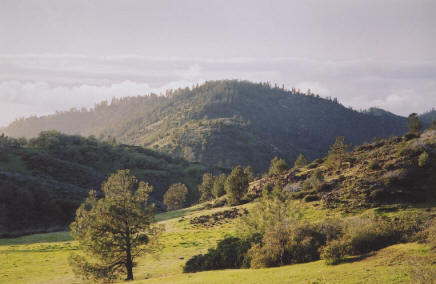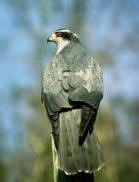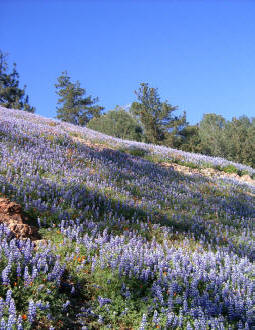|
October 17, 2005
FOREST SERVICE
AGREES TO PREPARE ENVIRONMENTAL ASSESSMENT FOR LOGGING PROJECTS
Studies Could
Protect Old Growth
Forests on Figueroa Mountain, Frazier Mountain, and Mt. Piños
In response to concerns voiced by ForestWatch, the
Forest Service has agreed to prepare detailed Environmental
Assessments before allowing logging in six areas of the Los Padres National
Forest.
The logging projects cover 7,350 acres of
forestland in popular recreation areas like Frazier Mountain in
Ventura County, Figueroa Mountain in Santa Barbara County, and
Mount Piños and Cerro Noroeste in Ventura and Kern counties.

The south
side of Figueroa Mountain, with a late afternoon fog bank
approaching. Photo © LPFW.
The agency first announced
the logging
proposals late last year. Along with the announcement, the agency declared
that it would not prepare an Environmental Assessment for the
logging plans.
| Normally, the Forest
Service is required to prepare an EA for most activities
on the forest. However, for these six logging projects, the Forest Service
tried to exploit a loophole called a "categorical
exclusion," which would allow the agency to begin logging
without first preparing an EA. This was illegal, because
under the Forest Service's own regulations, most of the
logging projects are so big that they don't even qualify
for a "categorical exclusion" in the first place. |
ENVIRONMENTAL
ASSESSMENT
A
short, formal report that studies ways to avoid
environmental damage. The National Environmental
Policy Act requires all federal agencies to prepare an
EA before they begin logging and other activities
that could harm the forest.
|

A
forest on Frazier Mountain after aggressive "thinning." The agency wants to
expand logging in this area as part of its Frazier Mountain
Project.
The agency accepted public
comments on its logging proposals earlier this year. At that
time, ForestWatch pointed out that these logging projects
did not qualify for a "categorical exclusion," and that the agency
needed to prepare an EA before logging could begin.
ForestWatch members also discussed the projects with agency
officials during two field trips.
However, officials continued to
propose new projects under the "categorical exclusion" loophole. When all else failed, and it appeared that the
agency would not address our concerns, ForestWatch submitted a
Notice of
Violation to the Forest Service and each district ranger. This notice outlined our main concerns with all projects, and
gave the agency one last chance to follow long-standing legal
requirements.
In response to our notice, the
agency agreed in early October to prepare full EAs for all six
projects. The six projects include:
|
Project
Name |
Location |
County |
Acres |
| Pine Mtn
Club Project |
14 mi E of
Frazier Park |
Kern |
1,860 |
| Figueroa
Mtn Project |
9 mi NE of
Los Olivos |
Santa
Barbara |
667 |
| Frazier
Mtn Project |
4 mi SW of
Frazier Park |
Ventura |
2,903 |
|
Organization Camps Project |
8 mi NW of
Frazier Park |
Kern |
700 |
| McGill -
Mt. Pinos Project |
12 mi W of
Frazier Park |
Kern/Ventura |
1,010 |
| Pine Mtn.
Rec. Area Project |
6 mi E of
Highway 33 |
Ventura |
210 |
| |
TOTAL |
|
7,350 |
Click
here for a map showing
the location of these projects.
 Unlike traditional commercial logging
operations, these six logging projects are not clear cuts and
are not being done for commercial purposes. Instead, the agency
is proposing to cut down some trees and removing some vegetation
while allowing others to remain. Unlike traditional commercial logging
operations, these six logging projects are not clear cuts and
are not being done for commercial purposes. Instead, the agency
is proposing to cut down some trees and removing some vegetation
while allowing others to remain.
An overgrown forest on Mt. Pinos.
The purpose of these
projects, according to the agency, is to reduce fire intensity
and to protect communities from wildfire. With less vegetation to
burn, the forests are more likely to survive a wildfire because the fire
will remain closer to the ground and not travel up the entire
tree or into populated areas.
 ForestWatch believes that the agency should spend its
scarce
funds where it's most effective - along the wildland urban
interface. We support efforts to reduce vegetation directly
alongside these communities. Removing trees and vegetation several miles
from communities will do little to protect faraway homes from
the threat of wildfire. ForestWatch believes that the agency should spend its
scarce
funds where it's most effective - along the wildland urban
interface. We support efforts to reduce vegetation directly
alongside these communities. Removing trees and vegetation several miles
from communities will do little to protect faraway homes from
the threat of wildfire.
We support
thinning of dense brush directly along the
Pine Mtn.
Club subdivision, where it's needed most.
Concern: Protection of Large Old-Growth
Trees
ForestWatch also supports these
projects because many of these forests are overgrown with small
trees and dense understory vegetation. There are some areas
where vegetation must be removed, but we became concerned after learning that the agency
planned to cut down trees as large as 30 inches in diameter or
larger. Some parts of the Figueroa Mountain Project would even
allow logging trees "of all ages and sizes."
The overwhelming amount of scientific evidence
suggests that cutting trees larger than 12 to 16 inches in
diameter actually increases, rather than decreases, fire risk.
This is because larger, older trees have strong fire resistance,
and if they are cut down, highly flammable brushy vegetation
grows in its place.
In the EA, the agency must
present sound scientific evidence to justify the cutting of
large trees. We hope the agency acknowledges the large body of
scientific evidence and restricts logging to small-diameter
trees in very limited areas.

Concern: Wildlife & Native American
Heritage Sites
ForestWatch
also asked the agency to provide adequate protections for rare
plants and animals that could be found in the logging areas,
including the Northern goshawk, California spotted owl, Mt. Pinos
blue grouse, and the Mt. Pinos lodgepole chipmunk.

The
EA will show whether these animals will be harmed by logging. ForestWatch
will review the final decision to make sure these rare animals
are afforded the highest protection.
The Mt.
Pinos blue grouse, a
rare bird. Photo © Jim Bland.
ForestWatch was also alarmed that logging
would be allowed to take place on Native
American sacred sites. For example, the Frazier Mountain Project
stated that, "Twenty heritage sites and isolates are located
within the project," but only required that "Three of these
sites would need to be totally avoided during project
activities."
Concern: New Road
Construction
For each logging project, the
Forest Service repeatedly emphasied that "no new roads would be
built." However, tucked inside the agency's proposal was a
provision that would allow the construction of "temporary
travelways."
ForestWatch believes that no
new roads, temporary or otherwise, should be constructed as part
of these projects. All vehicles should remain on existing roads
that pass through the logging areas. New roads are unnecessary,
will encourage trespass by off-highway vehicles, and will
contribute to the spread of invasive weeds and send sediment
into nearby streams.
Next Steps
 The
agency will spend the next few months preparing the EA. When
finished, it must release the EA for public comment before
issuing its decision. The
agency will spend the next few months preparing the EA. When
finished, it must release the EA for public comment before
issuing its decision.
Officials expect to issue a
decision on the Figueroa Mountain Project in January 2006. The
other logging projects will be completed in May 2006.
ForestWatch will continue to monitor these
projects, and will work with the agency to ensure that the final
decision makes sense from a wildlife, fire prevention, and
recreation standpoint.
A field of
lupines in bloom
on Figueroa Mountain.
Photo © LPFW, Inc. |

